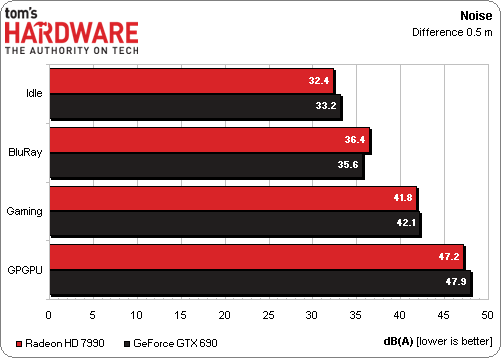AMD Radeon HD 7990: Eight Games And A Beastly Card For $1,000
We've been waiting for this since 2011. AMD is ready to unveil its Radeon HD 7990, featuring a pair of Tahiti graphics processors. Can the dual-slot board capture our hearts with great compute and 3D performance, or does Nvidia walk away with this round?
Noise Measurements And Fan Speed
All of our measurements are taken in a semi-anechoic chamber at an ambient temperature of 22° C from a distance of 50 cm (19.7 inches), with the microphone perpendicular to the middle fan of the Radeon HD 7990. As always, we report noise levels in dB(A) to account for the human ear’s idiosyncrasies as much as possible.
These tests employ the same calibrated setup used for our PC audio testing, since our studio microphone enables more precise measurements at frequencies above 8 kHz than a sound-level measuring device. Why go to all of that extra effort? Because sound pressure level doesn’t tell the whole story. Although we actually like the acoustics of the Radeon HD 7990’s triple-fan cooler a little more than GeForce GTX 690’s single-fan solution, we also have to live with the fact that, this time around, fan noise isn’t what you’re most likely to hear while you game. As mentioned earlier on, variable loads cause the card’s ceramic capacitors and PCB to vibrate, resulting in a whining sound that grates on your ears.
The company says it actually did quite a bit to minimize this, and you can further help by enabling v-sync to limit frame rates. This brings us back to our analysis and the fact that subjective impressions are a lot different than what an SPL meter would have reported. Don’t worry—we have video to make all of this clearer.
Temperatures, Fan Curves, and Sound Levels
Our first point of interest is comparing the Radeon HD 7990’s maximum temperature to GeForce GTX 690. Both cards are taxed using a GPGPU-oriented application that generates a continuous 100% load. While Nvidia’s dual-GPU board runs at a constant 914.5 MHz, unable to accelerate its core clock any higher, the Radeon HD 7990’s frequency oscillates between 950 and 1000 MHz even after ten minutes, though it tends to trend closer to the base clock rate.
As we can see, the Radeon HD 7990 runs slightly cooler. But how do those temperatures correspond to fan speed?
Unlike the GeForce GTX 690, which sports a center-mounted axial fan using large blades set at a rather sharp angle, AMD’s Radeon HD 7990 is equipped with three axial fans, each of which employing blades that are more curved and set at a shallower angle. This paves the way for lower noise levels and temperatures, even though the trio of blowers rotate faster, too.
Get Tom's Hardware's best news and in-depth reviews, straight to your inbox.
AMD’s fan curve is less granular than Nvidia’s, though it’s also generally more conservative. The 7990’s fans spin slower at temperatures under 60°C. In theory, this could yield very low noise output at idle or when the card encounters a moderate load. That’d be quite a coup for AMD, which struggled with noise in the past, but appears to have a real winner in its Radeon HD 7990. Unfortunately, though, more taxing applications trigger the whining issue that creates more noise than the fans.
What AMD refers to as capacitor and PCB vibration ends up costing the Radeon HD 7990 its theoretical advantage. It’d be great to see AMD fix this and really redefine what it means to sell a flagship dual-GPU card that barely makes a whisper.
This takes us to our next question: How much of the noise is actually generated by the fans themselves?
Current page: Noise Measurements And Fan Speed
Prev Page Radeon HD 7990 Vs. GeForce GTX 690: The Pepsi Challenge Next Page Noise Analysis: Frequency Spectrum And Videos



